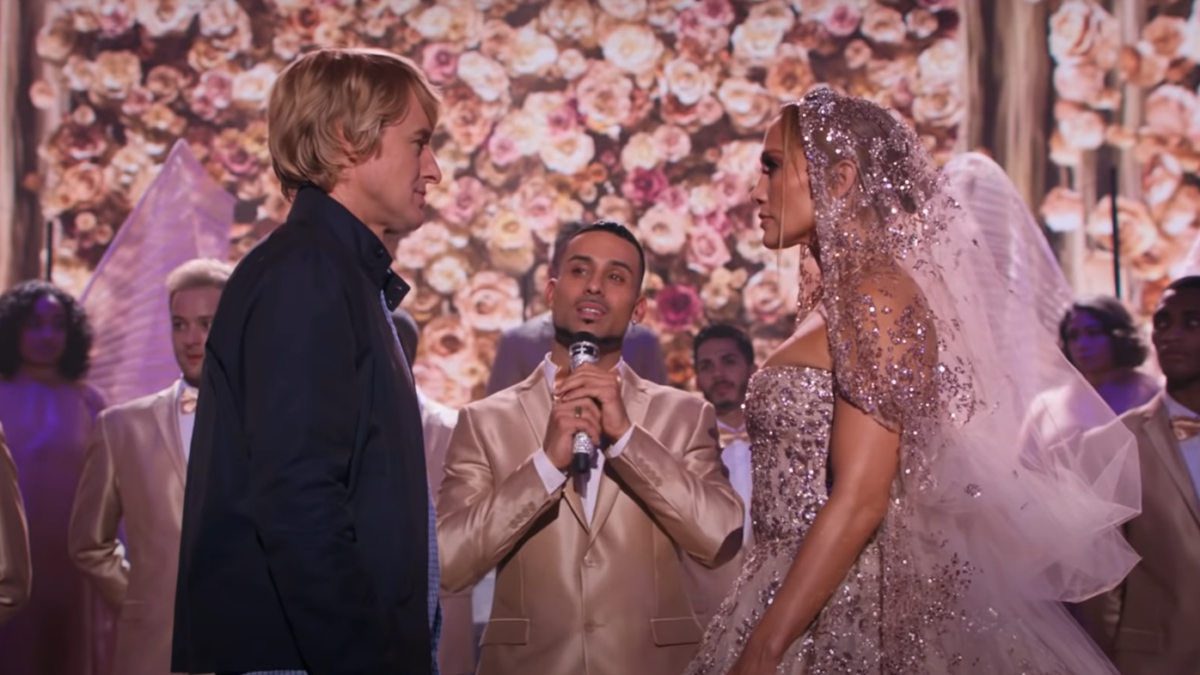Jennifer Lopez’s new rom-com, “Marry Me,” is neither romantic nor comical. Yet Forbes calls the movie a return to old Hollywood classics, saying, “It’s not remotely deconstructionist or subversive. It’s a deeply old-fashioned star-driven rom-com that doesn’t apologize for itself or spend its running time trying to be ‘not your usual romantic comedy.'”
This could not be further from the truth.
The plot is completely unrealistic, even by rom-com standards: Lopez plays Kat Valdez, a superstar musician who plans to marry her fiancé and fellow singer Bastian on stage in front of 20 million fans as they perform their new hit single, “Marry Me” — until a social media leak reveals, moments before the wedding, that Bastian cheated on her. In a flash, Kat decides to marry a random audience member instead, and selects math teacher and single dad Charlie (Owen Wilson), whose personality can best be likened to that of a golden retriever.
Nothing of Substance Here
While the movie may be full of romantic tropes and unearned allusions to classics like “Pretty Woman” or “When Harry Met Sally,” it is also teeming with typical postmodern, feminist lingo. Kat’s appalling performance of the song “Church” features half-nude dancers wearing priest’s collars and nun’s veils (please do not allow your children to watch this movie).
In another scene, Kat asks reporters, “Why do we need to wait for men to propose? Why is everything on his terms? No, I think it is time to shake things up. How about this? We pick the guy, we keep our name, and let him earn the right to stay.”
More importantly, the film does not explore any of these themes — traditional or inverted — in depth, because the frenzied, social-media-montage pace makes true reflection impossible.
The movie script cannot properly be called dialogue; it is not a means of interaction and self-revelation between characters, but a collection of clichés and soundbites. Two-thirds of the way through the film, I was shocked to realize I still had not witnessed a single meaningful conversation, just hurried exchanges or flashy montages.
A Social Media Dystopia
Unrealistic plot and meaningless dialogue aside, it is the use of social media that makes “Marry Me” feel like a dystopian shadow of true moviemaking. Many scenes depict not only the plot playing out in “in real time” but also the public’s immediate reaction to it, through Instagram Live feeds and Snapchat, which occasionally pop up on the screen and remind us that everything in Kat’s life is being watched, recorded, and commented upon by the entire world.
As a result, the “reaction of the public” becomes a driving force of the movie and a character in its own right. Kat and Charlie decide to stay married for three months “until the public calms down” after the Bastian scandal. Because of the constant global feedback that permeates the film, individual characters are never fully developed, and everyone is subject to the eerie monster of groupthink.
Although this is not only true of “Marry Me” (I’ve had similar reactions to other recent movies) it is frightening to see how each character seems more like an image or a blank identity than a human being. Characters are hardly ever dynamic unless they act collectively, within the sanctioning context of social media.
Social Media Distorts Actual Interactions
In the 1960s Audrey Hepburn heist movie, “How to Steal a Million,” Simon Dermott tells Nicole Bonnet that they will steal a “Cellini Venus” statue from the museum by relying on “normal human reactions.” Simon predicts ahead of time exactly how the security guards will react to each twist and turn of his plan of attack, and the result is a heist that doubles as a clever study in human psychology.
“Marry Me” is the exact opposite. The reactions of the public often seem completely un-normal — as if they weren’t real people at all, but impersonal puppets serving the convenience of the film producers.
Each time Kat Valdez runs through an airport or steps into a school auditorium, no one in the crowd reacts the way I would have anticipated. I would expect people to rush up to her, screaming and clamoring for an autograph or a picture. Instead, everyone conveniently stays in place, quiets down, and immediately begins filming the situation on their iPhone (cue yet another social media montage).
Is this an intentional move by the film producers, hoping to create a less chaotic and more “scripted” scene? Or have even our in-person interactions been so fundamentally changed by social media that such detached, impersonal reactions are in fact the new “normal”? Either way, the result remains the same: The scene is no longer Kat’s story, but the world’s collective Snapchat story.
Throughout the film, Charlie is the only character who seems uncomfortable with the emphasis on social media, calling it “kind of a distorted reality,” but this theme is glossed over and never allowed to develop. When Charlie challenges Kat to spend a few days without any social media, assistants, or cameramen filming her every move, she in turn challenges him to “get on social media” and use it as a tool to make his math classroom more interesting.
Rather than exploring this juxtaposition in any meaningful way, however, these scenes devolve into fast-paced montages of Charlie and Kat enjoying a romantic, internet-free getaway, or Kat teaching Charlie’s students how to dance while doing math problems.
The movie is a glorified TikTok video. If that qualifies as “deeply old-fashioned,” I am terrified for the future of the film industry — and our society.









